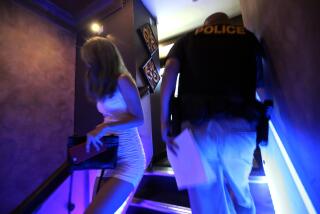Singing for the Masses in the Privacy of Home
- Share via
Pablo Retes is a 47-year-old police instructor in Nayarit, Mexico. Anne Hiscock, 44, is a Web site administrator half a world away in Tasmania. But on any given day, they may be crooning directly to each other--and to a worldwide cyber-karaoke audience of 50,000 would-be pop singers.
“When I sing an Elvis tune, the world’s out there listening,” says Retes, one of a growing number of karaoke fans letting loose on the Internet. “I never sing in bars. Just on the Web.”
Adds Hiscock: “It’s wonderful. You hear people singing from just about every country, in just about every language.”
And she’s right. On one recent day in their meeting place, PalTalk.com, a deep-voiced lounge lizard was belting out a version of Frank Sinatra’s “My Way”--in Arabic.
Retes, Hiscock and their friends are taking advantage of improved technology and a communications revolution that has pumped up interest in karaoke--a lowbrow entertainment form that the music media regard with the same esteem that sports pages reserve for bowling and demolition derbies.
Born in Japan but now a staple in saloons, nightclubs, cruise ship lounges and dance halls around the world, karaoke machines give would-be stars a chance to sing with the band by playing background instrumentals to hit songs while the words flash on a TV screen in synchronization with the music.
In the past few years, hybrid compact discs and inexpensive players have brought karaoke out of the barroom and into the home--and from there to the World Wide Web.
Retes and Hiscock, for example, use a simple program called PalTalk that allows any singer with a computer and a microphone to broadcast over the Web. Using Internet telephony--a variety of real-time voice conferencing--karaoke singers can visit any PalTalk.com chat room and wait their turn and become digital rock-and-rollers.
*
“It’s a great outlet for anyone who’s too shy to do karaoke in a bar,” said Jason Katz, PalTalk’s 37-year-old chief executive, who spoke with a reporter via microphone from a PalTalk.com chat room (but declined to sing).
“The great thing about the Web is that you’re not limited to a couple of local karaoke clubs up the street from your house,” he said. “The Internet is the best means of communication ever built, and it can be used for all kinds of mind-boggling applications.”
For those who prefer to sing in private, sites such as Cowboy Karaoke https://(www.cowboykaraoke.com) use streaming audio and video to transmit sound files and rolling lyrics for hundreds of songs. Just click on any tune in the catalog (which ranges from the Beatles to Britney Spears), and it plays on your computer while you sing along.
And for Web surfers looking for traditional equipment, the karaoke capital of cyberspace is in a modest, out-of-the-way warehouse in a White Marsh, Md., office park. That’s where former disc jockey Greg Lazzaroni, 42, runs Karaoke.com, which sold more than $6 million worth of karaoke hardware, software, discs and other supplies online last year.
Lazzaroni came up with the idea for the business almost 11 years ago while working in the back of his father’s music store. At the time, Lazzaroni was also running a disc jockey business with a high school friend, David Nolte, now his partner.
“My father told me about this new thing called karaoke--he had a laser disc with Frank Sinatra on it--and I remember being a little skeptical at first,” Lazzaroni recalled. “I said, ‘Dad, nobody in America is going to do this.’ ”
But Lazzaroni tempered his skepticism with a longshot cyber-bet when he plunked down $35 in 1995 to register the Web domain name Karaoke.com. It turned out to be a brilliant move, because that’s the address that most karaoke surfers try first.
Lazzaroni expects his business to grow to $8 million this year, and it’s almost all thanks to the Web. In fact, he permanently closed his walk-in store early last year.
“People get addicted to karaoke in the bar, and they come to us to feed their habit,” said Lazzaroni, sitting in a small, colorful office surrounded by CDGs (karaoke compact discs with graphics), players, and music posters. On one shelf is a bottle of Chivas Regal that a happy customer sent him; on another is a six-pack of Three Stooges Beer, with two bottles missing.
A half-dozen or so Mac computers hum in a nearby tiny room, and Karaoke.com’s tech manager, Deane Miner, explains that it’s from here that Karaoke.com reaches out to the Web. He shows a Web server report that indicates karaoke is indeed alive and well around the world--just this day, the site has been visited by more than 6,000 people in dozens of countries, including Thailand, Brazil, Norway, Cyprus, China, South Africa and Ukraine.
*
Karaoke.com’s message board, called Jolt, is crammed with hundreds of postings each day, from health topics (you should clean the microphone with a moist towelette before you grab it) to advice for the karaoke lovelorn (how to meet the singer of your dreams while performing Patsy Cline hits).
One of the nation’s largest collections of karaoke CDGs is in the home of Catonsville, Md., resident Charles McElhose, known as “Karaoke Charlie” to those who follow his professional night club gigs as a karaoke jockey (or KJ).
When he wasn’t busy with his main business, installing burglar alarms, the 45-year-old McElhose managed to amass a staggering library of 42,400 karaoke songs on 7,000 CDGs.
He estimates that he’s spent $200,000 on his collection.
“I’m going computerized,” he said. “I’ve been putting more and more karaoke songs on my 80-gig external hard drive. I have some extremely rare CDGs, and I want to save them on the computer.”
Unlike standard audio CDs, karaoke CDGs are produced in limited runs by companies that hire their own bands and arrangers. They’re rarely re-released--so once a rare version of a karaoke song is destroyed, there are no backup copies to be bought.
More to Read
Sign up for Essential California
The most important California stories and recommendations in your inbox every morning.
You may occasionally receive promotional content from the Los Angeles Times.













